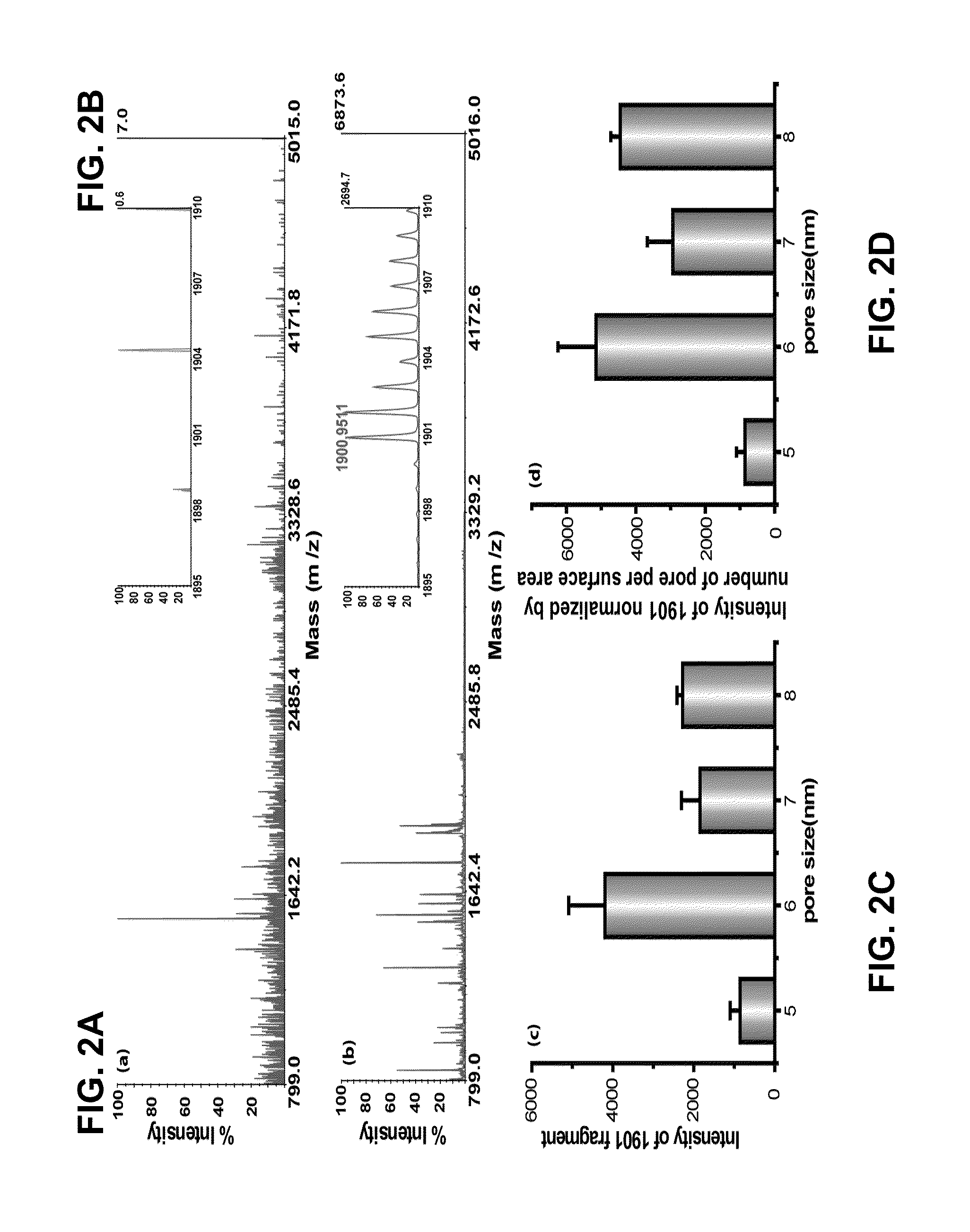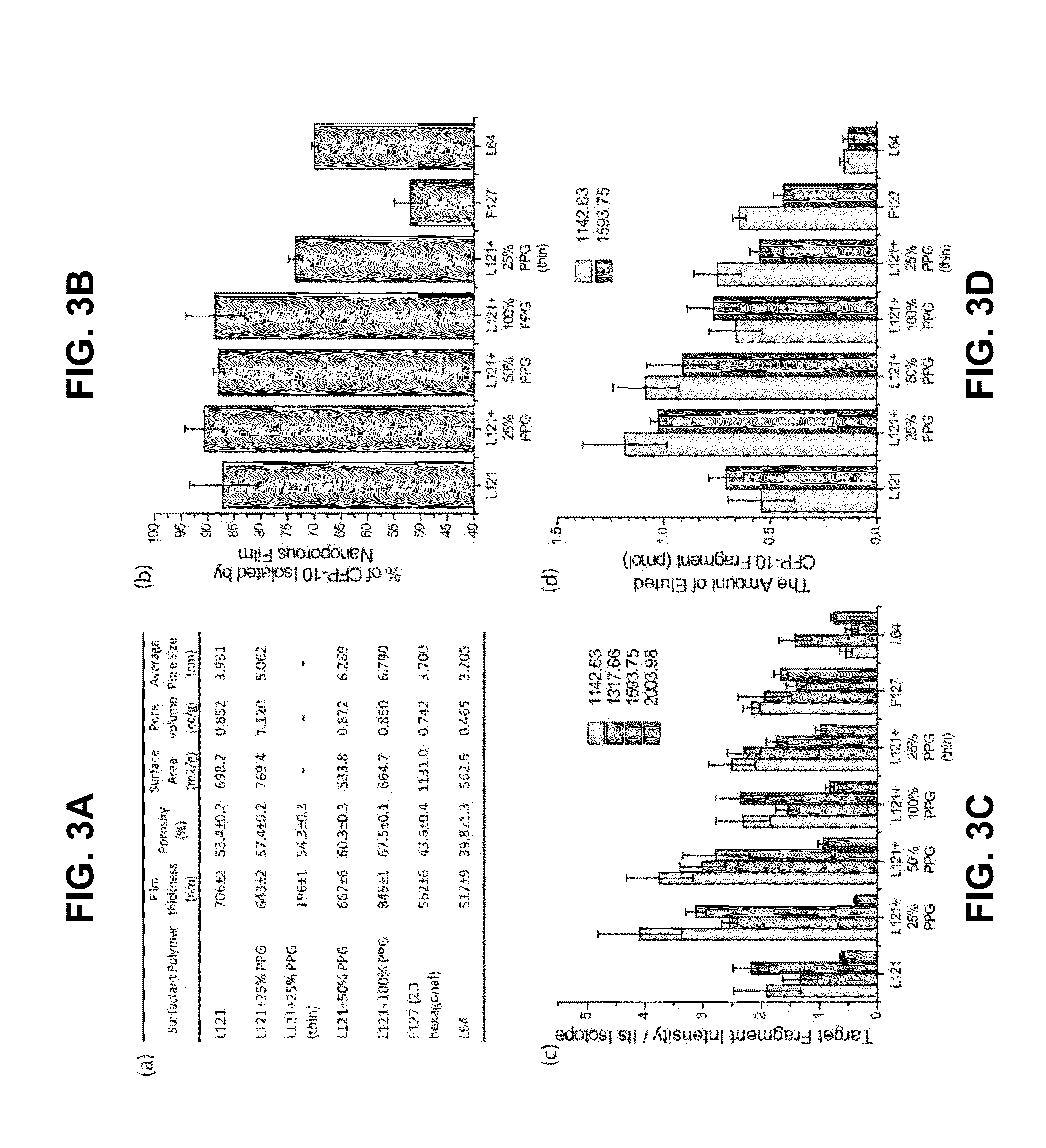Rapid detection and quantitation of pathogen-specific biomarkers using nanoporous dual- or multi-layer silica films
a biomarker and nanoporous technology, applied in the field of molecular biology and medicine, can solve the problems of increasing the difficulty of identifying tb in the highly vulnerable human-immunodeficiency virus population, and the difficulty of tb detection in pediatric patients, so as to facilitate the fractionation and digestion of samples on the chip, and facilitate the detection and quantification of such biomarkers. the effect of high detection accuracy
- Summary
- Abstract
- Description
- Claims
- Application Information
AI Technical Summary
Benefits of technology
Problems solved by technology
Method used
Image
Examples
example 1
ESAT-6 Detection
[0163]Fabrication and Characterization of Nanoporous Silica Thin Films.
[0164]The general methods for fabrication of nanoporous silica thin films are described in the art (see e.g., Bouamrani et al., 2010; Hu et al., 2010; Hu et al., 2011; and U.S. Patent Appl. Publ. No. 2011 / 0065207). Briefly, the coating silicate sol was prepared by adding 14 mL of tetraethyl orthosilicate (TEOS) into a mixture of 17 mL of ethanol, 6.5 mL of distilled water, and 0.5 mL of 6 M HCl and stirred for 2 hrs at 80° C. to form a clear silicate sol. After cooling to room temperature, 10 mL of silicate sol was added to a mixture of 1.2 g of Pluronic L121, 10 mL of ethanol, and differing amounts of polypropylene glycol (PPG). The coating solution was stirred at room temperature for 2 hr, and deposited on a Si(100) wafer by spin-coating at a spin rate of 2500 rpm for 20 sec. To increase the degree of polymerization of the silica framework in the films, and to further improve their thermal stabi...
example 2
On-Chip Fractionation and Digestion of ESAT-6
[0166]Normal human serum was obtained from Valley Biomedical (Winchester, Va., USA). Recombinant ESAT-6 was purchased from Diagnostics, Inc. (Woburn, Mass., USA). As shown in FIG. 1A, FIG. 1B, and FIG. 1C, 6 μL of protein solutions was pipetted onto the silica nanoporous film and incubated for 30 min in a humidified chamber at room temperature. The protein solution was then discarded, and 10 μL of deionized water was applied onto the silica porous film to wash away larger proteins. The washing process was then repeated three times. For enzymatic digestion, 10 μL of 0.01 mg / mL trypsin dissolved in 100 mM sodium bicarbonate was applied onto the silica nanoporous film and incubated overnight at 37° C. 10 μL of elution buffer (0.1% trifluoroacetic acid [TFA]+50% acetonitrile [ACN]) was then pipetted to extract the protein fragments. The elution buffer was then removed and stored in microcentrifuge tubes for MALDI-TOF MS analysis. To test the ...
example 3
ESAT-6 / CFP-10 Detection Analyses
[0174]An exemplary detection procedure in accordance with one aspect of the present invention is illustrated in FIG. 1A. The biological samples were applied to a silicone gasket culture well (3-mm diameter and 1-mm height) attached on top of the nanoporous silica film. The fractionation process was completed after serial washes as described in Examples 1 and 2. Because the silica films were fixed on the flat substrate, the fractionation process was easily applied without any inconvenient washing procedure, such as sedimentation steps usually required in particle-based systems. The relatively small size of ESAT-6 (MW=10 kDa) allowed it to be captured by the silica nanopores. To identify ESAT-6 protein from biological fluids with MALDI-TOF MS, a mass fingerprinting must first be established. Because smaller protein or peptides species provide higher signals and resolution in MS and full-length ESAT-6 (10 kDa) is relatively large for MALDI-TOF MS under l...
PUM
 Login to View More
Login to View More Abstract
Description
Claims
Application Information
 Login to View More
Login to View More - R&D
- Intellectual Property
- Life Sciences
- Materials
- Tech Scout
- Unparalleled Data Quality
- Higher Quality Content
- 60% Fewer Hallucinations
Browse by: Latest US Patents, China's latest patents, Technical Efficacy Thesaurus, Application Domain, Technology Topic, Popular Technical Reports.
© 2025 PatSnap. All rights reserved.Legal|Privacy policy|Modern Slavery Act Transparency Statement|Sitemap|About US| Contact US: help@patsnap.com



